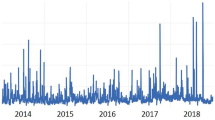Abstract
Sales promotion is a primary tool included in the marketing mix that can arbitrate the sales trend. Retailers need to deploy business analytics to measure and define key performance indicators to determine an accurate measurement of return in investment for individual promotions. In this context, the need for an advanced Decision Support System (DSS) to orchestrate promotion strategy is critical for the companies. A brand-level model, which will assess promotional performances of brands within the category, could provide a helpful tool to retailers both for category management and price promotions activity allocation. This research estimates promotion/sales elasticity models for 11 brand-category groups to assess promotion efficiency using the ARDL bounds test method. Brand-level model, we estimated points that own price and promotion depth effect have the most significant impact magnitude on sales. Auto-regressive Distributed Lag type models we employed for this analysis enable us to differentiate long- and short-term analysis.
Access this chapter
Tax calculation will be finalised at checkout
Purchases are for personal use only
Similar content being viewed by others
References
Andersen, E.T., Simester, D.I.: Long-run effects of promotion depth on new versus established customers: three field studies. Mark. Sci. 23(1), 4–20 (2004). https://doi.org/10.1287/mksc.1030.0040
Anderson, E.T., Fox, E.J.: How price promotions work: a review of practice and theory. In: Dubé, J.P., Rossi, P.F. (eds.) Handbook of the Economics of Marketing, vol. 1, chap. 9, pp. 497–552, 1 edn. North Holland, Amsterdam (2019). https://doi.org/10.1016/bs.hem.2019.04.006
Association, A.M.: Definition of marketing (2017). https://www.ama.org/the-definition-of-marketing-what-is-marketing/
Bell, D.R., Chiang, J., Padmanabhan, V.: The decomposition of promotional response: an empirical generalization. Mark. Sci. 18(4), 504–526 (1999). http://www.jstor.org/stable/193240
Gupta, S.: Impact of sales promotions on when, what, and how much to buy. J. Mark. Res. 25(4), 342–355 (1988)
van Heerde, H.J., Neslin, S.A.: Sales promotion Models. In: Wierenga, B., van der Lans, R. (eds.) Handbook of Marketing Decision Models, vol. 254, chap. Sales Prom, pp. 13–77. Springer, Cham, internatio edn. (2017). https://doi.org/10.1007/978-3-319-56941-32
Klein, L.R.: The estimation of distributed lags. Econometrica 26(4), 553–565 (1958). https://doi.org/10.2307/1907516. http://www.jstor.org/stable/1907516
Koyck, L.M.: Distributed Lags and Investment Analysis. North-Holland Publishing Company, Amsterdam (1954)
Leeflang, P.S., Parreño Selva, J., Van Dijk, A., Wittink, D.R.: Decomposing the sales promotion bump accounting for cross-category effects. Int. J. Res. Mark. 25(3), 201–214 (2008). https://doi.org/10.1016/j.ijresmar.2008.03.003
Parsons, L.J., Schultz, R.L.: Marketing Models and Econometric Research. North Holland, Amsterdam (1976)
Pesaran, M.H., Shin, Y., Smith, R.J.: Bounds testing approaches to the analysis of level relationships. J. Appl. Econom. 16(3), 289–326 (2001). https://doi.org/10.1002/jae.616
Van Heerde, H.J., Gupta, S., Wittink, D.R.: Is 75% of the sales promotion bump due to brand switching? No, only 33% is. J. Mark. Res. 40(4), 481–491 (2003)
Varian, H.R.: A model of sales. Am. Econ. Rev. 70(4), 651–659 (1980)
Zellner, A.: An efficient method of estimating seemingly unrelated regressions and tests for aggregation bias. J. Am. Stat. Assoc. 57(298), 348–368 (1962). https://doi.org/10.1080/01621459.1962.10480664. https://www.tandfonline.com/doi/abs/10.1080/01621459.1962.10480664
Author information
Authors and Affiliations
Corresponding author
Editor information
Editors and Affiliations
Rights and permissions
Copyright information
© 2022 The Author(s), under exclusive license to Springer Nature Switzerland AG
About this paper
Cite this paper
Zeybek, Ö., Ülengin, B. (2022). Sales Promotion Effectiveness: The Impact of Category – Brand Level Price Promotions on Sales Performance of a Large Retailer. In: Kahraman, C., Cebi, S., Cevik Onar, S., Oztaysi, B., Tolga, A.C., Sari, I.U. (eds) Intelligent and Fuzzy Techniques for Emerging Conditions and Digital Transformation. INFUS 2021. Lecture Notes in Networks and Systems, vol 307. Springer, Cham. https://doi.org/10.1007/978-3-030-85626-7_107
Download citation
DOI: https://doi.org/10.1007/978-3-030-85626-7_107
Published:
Publisher Name: Springer, Cham
Print ISBN: 978-3-030-85625-0
Online ISBN: 978-3-030-85626-7
eBook Packages: Intelligent Technologies and RoboticsIntelligent Technologies and Robotics (R0)




